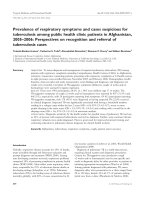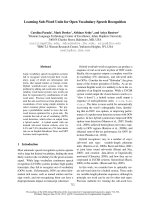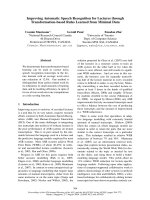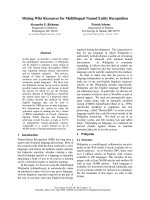Iris recognition for biometric passport authentication
Bạn đang xem bản rút gọn của tài liệu. Xem và tải ngay bản đầy đủ của tài liệu tại đây (863.35 KB, 7 trang )
<span class='text_page_counter'>(1)</span><div class='page_container' data-page=1>
VNU <sub>Journal of Science, </sub>Natural Sciences and Technology 26 (2010) M-20
Iris recognition
for
biometric
passport
authentication
Nguyen Ngoc
Hoa*
':*'o
of Informa'lionrechnotogv':':::"::,:::::::,:'
t44 xuan rhuv' Hanoi' vietnamAbstract. This paper investigates an aspect of using iris recognition to authenticate a biometric
passport. For this kind of authentication, two citizen's iris will be captured and stored on a RFID
(Radio Frequency Identification) chip within two other biometrics: face and hngerprint. This chip
is integrated into the cover of a passport, called a biometric passport. By using the iris recognition,
a process of biometric passport authentication was presented in this paper by using the extended
acces control, and allows integrate the verification result
of
theiris,
face and fingerprintrecognition. The integrating experiment will allow validate the accuracy of proprosal model in the
near fufure.
Keywords: Biometric passport, extended access control, iris recognition, iris localization, iris
extraction, iris matching.
,
l.
Introductionkis
recognitionbrings more
advantagesovers other biometric modalities as frngerprints,
face,...
It
dependson the
uniquenessof
thehuman biometrics:
iris.
The lateris
a
uniqueorgan that
is
composedof
pigmented vesselsand ligaments
forming
unique linear marks,slight ridges, gooves, firrrows, vasculature... [1].
Thus, comparing more features of iris allows to
increase the likelihood
of
uniqueness. Anotherbenefit of this biometric is its stability. The iris
remains unchanged
for
a lifetime becauseit
isnot
subjectedto
the
environment,as
it
isprotected
by
the comea and aqueous humor.Therefore, many biometric researchers have
used
iris
recognition
for
high
confidenceverificatiorVidentification and
this
hasled
toextensive studies
in
developing iris recognition' Tel: 84-4-37547813.
E-mail :
techniques
in
unconstrained environments,where the probability of acquinng non-ideal iris
images
is
veryhigh
dueto
off-angles, noise,bluning
and occlusionby
eyelashes, eyelids,glasses, and hair.
T
J
'1
q4
5
(t
Fignrcrt ilrill
Pnpill+ry ar*
Col.l:rcrte
Cilirin crta
Cr;*pts
Pignrenl spol
f,t'i'X,
l4
</div>
<span class='text_page_counter'>(2)</span><div class='page_container' data-page=2>
N.N. Hoa / WU lournal of Science, Natural Sciences and Technology 26 (2010)
La-20
15The process
of
iris recognition is complex.It
beginsby
scanninga
person'siris
by
aspecial camera
<sub>[2]. </sub>
Then,by
usinga
imageprocessing technique, the iris
will
be located inthe
capturedimage following
by
anothertechnique used to encodes the iris into a phase
code (2048-bit)
<sub>t3l. </sub>
The phase codeis
thencompared
with
a
databaseof
phase codeslooking for a match. This step is normally very
quick: more
than
100,000iris
codes can becompared
in
a
second executedin
a
normalcomputer
[].
In this paper, we concentrate to the view
of
using
iris
recognitionin
the wayof
applyingthis
biometricfor
enhancingthe
processof
biometric passport authentication. In the rest
of
this paper, we first introduce current approachs
of
iris
recognition.The
biometric
passportconcept
will
be
detailedin
the next
sectionbefore the proposal integrating this biometric
feature in the biometric oassoort authentication.'
2.
Iris
recognition: stateofthe art
A typical iris recognition system commonly
comprises
six
stages:iris
image capture, irissegmentation,
iris
normalization,
irispreprocessing (eyelids/eyelashes detection and
iris image enhancement), feature extraction, and
matching.
Many researchers have worked on various
algorithms
for
iris recognition. Daugman <sub>[1,3]</sub>proposed a system based on phase code, using
multi-scale Gabor wavelets for iris recognition
and reported that
it
has excellent performanceon a large database of many images. <sub>Wildes [4]</sub>
described a method based on a pyramid of
low-pass filtered images at different scales and then
using
the
normalized correlation
to
findsimilarity of pixel intensities in the iris. Boles et
al. [5] proposed an algorithm for extracting the
ins
features using zero crossing representationof
l-D
wavelet transform. However,all
thesealgorithms are based on grey images because
of
its
important information enoughto
identiffdifferent individuals.
Fig.2. Example of iris pattern [3].
The iris
identification/verification
isbasically divided
in
four steps: iris acquisition,localization, feature extraction and matching.
Fig.3. Stages of an iris recognition system.
2.1. Acquiring the iris
The
iris
acquiritionis
an important stage.Since iris is small in size and dark in color, it is
difficult
to
acquire good image. Thus,it
isnormally captured
by
a
special camera. Thelater
will
be used to take eye snaps while tryingto maintain appropriate setting such as lighting,
distance
to
the
camera and resolutionof
theimage.
The
camera needsto
be
able
tophotograph
a
picture
in
the
700
to
900nanometers range so that
it
will
not be detectedby the
person'siris
during imaging<sub>[2]. </sub>
The</div>
<span class='text_page_counter'>(3)</span><div class='page_container' data-page=3>
I
6
N.N. Hoa I WU lournal of Science, Natural Sciences and Technology 25 (20L0) L4-20In
caseof
lackof
the special camara forcapturing
the
iris
images,we
can use
theCASIAT
iris
image corpus availablein
thepublic
domainfor
experiment.This
corpuscontains a total of 22,051 iris images from more
than 700 subjects. A11 iris images are already 8
bit
grayJevel JPEG files, collected uncier nearinfrared illumination.
2.2. Locating the iris
Once the image
of
theiris is
obtained, theiris needs to be located within the image. There
are three variables
within the
image that areneeded
to
fully
locate
the
iris:
the
centercoordinates, the iris radius, and the pupil radius
[3].
An
algorithm determinesthe
maximumcontour integral derivatives
using
the
threevariables to define a path of contour integration
for each of the variables.The complex analysis
of
the
algorithm
finds
the
contour
pathsdefining the outer and inner circumferences
of
the
iris.
Statistical estimation changes thecircular paths
of
the integral derivativestoarc-shaped paths that best fit both iris boundaries.
Fig.
4
shows the overall procedureof
therecent method
for
localizingthe iris
regionwithin the eye image
<sub>[6]. </sub>
In
this method, theinner and outer boundaries
of
theiris
regionsare
detectedby
using
two
circular
edgedetection (CED) <sub>[7]. </sub>However, detection errors
due to noise factors, such as occlusions of the
eye due
to
eyeglassesand
hair, are
oftenobserved. Therefole,
the
detected images aredivided into tv.'r cases, namely "good-detection
eases" and "bad-detection cases", based on the
existence of corneal specular reflection (SR). In
the "good-detection cases", the pupil and iris
I See
,
formore detail information
of
CASIA iris imagedatabase
-
Instituteof
Automation ChineseAcademy of Sciences.
regions are correctly detected, and in the
"bad-detection cases", they are wrongly detected <sub>[6].</sub>
Fig.4. Iris locating process <sub>[6].</sub>
2.3. Extracting the iris <sub>features</sub>
Once the
iris
has been located.it
must beencoded into an iris phase code. Daugman uses
2D
Gaborfilters
to
createmore than
twothousand phase
bits
from
a
raw
imagein
adimensionless
polar
<sub>coordinate system [1,3].</sub>These kinds
of
filter
usedfor
iris
recognitionare defined
in
the doubly dimensionless polarCoordinate system(r,0) as follow:
G(r,0) -
,-io(0-0)
,-('-'J2
ta2 ,-ip-0012 r p2Where
r
and0
specifu the locationof
thefunction across the zones of analysis of iris. The
q, and
<sub>B </sub>
arethe
multiscale2D
wavelet sizeparameters.
And
cois
the wavelet frequency.Each isolated iris pattem is then demodulated to
extract its phase information using quadrature
2D Gabor wavelets.
The disadvantage
of
the Gaborfilter,
notbeing band pass filters, lies on the fact that DC
component whenever the bandwidth
is
largerthan one octave
<sub>[8]. </sub>
However, the Log-Gaborfilters are strictly band pass filters. So no DC
7- Ey. ir cloed
</div>
<span class='text_page_counter'>(4)</span><div class='page_container' data-page=4>
N.N. Hoa / WU lournal of Science, Natural Sciences anilTechnology 26 (201.0) 74-20 T7
components
will
pass the filters.<sub>[9] </sub>
proposesconvolving the normalized iris pattem with 2D
Log-Gabor filters to generate iris code.
Another approach
for
features extractionwas proposed
by
<sub>[10]. This </sub>
method uses 2DDiscrete Wavelet Transform (DWT) in order to
extract the iris featwes. Results of using DWT
for
several
kinds
of
wavelets:
Haar.Daubdchies, symlets...
allow
to
validate theoptimization of processing time and space.
2.3. Matching iris codes
Applying the
matching algorithmon
theinput
iris
image andiris
code existingin
thedatabase does
the
iris
recognition. Normally,matching algorithm
allows
to
determine thesimilarity between
two
given data sets. Thus,the iris image is said to be authentic
if
the resultobtained after matching is more than the present
threshold value.
Specifically, the number
of
iris
code bitsthat need
to
correspondfor
a
match must bedetermined
<sub>t3]. </sub>
The
number
of
code
bitsrequired
for
a matchis
decided based on thespecific application regarding how many irises
need
to
be
compared.The
criteria
used todecide
if
iris
codesmatch
is
called
theHamming Distance (HD) criterion, which is the
integration of the density function raised to the
power of the number of independent tests.
Two
similar iriseswill
fail
this test sincedistance between them
will
be small. The testof
matching
is
implementedby
the
simpleBoolean Exclusive-OR operator (XOR) applied
to the 2048
bit
phase vectors that encode anytwo iris patterns <sub>[3]. Letting </sub>A and B be two iris
representations
to
be
compared,this
quantitycan be calculated as with subscript
<sub>J' </sub>
indexingbit
positionand
denotingthe
exclusive-ORoperator.
HD=
|
'yA,@8,
20481
A
smaller criterion results
in
anexponentially decreasing chance
of
having afalse
match.This
allows
the
strictnessof
matching
irises
to
easily
changefor
theparticular application.
A
Hamming distancecriterion of 0.26 gives the odds of a false match
of
I
in
10trillion,
while
a
criterionof
0.32gives the odds
of
I
in
26 million.The numericvalues of 0.26 and 0.32 represent the fractional
amount that two iris codes can differ while still
being considered
a
matchin
their respectiveinstances <sub>[1 </sub>I <sub>].</sub>
3. Biometric passport
A
biometric passport,or
e-passport,is
acombined
paper
and
electronic
identitydocument that uses biometrics
to
authenticatethe
identity
of
travelers.It
uses contactlesssmart
card
(using
the
RFID2
technology),including
a
microprocessorchip
(computerchip) and antenna (for both power to the chip
and communication) embedded
in
the front orback cover, or centre page, ofthe passport. The
passport's critical information is both printed on
the data page
of
the passport and stored in thechip. Public Key Infrastructure (PKI) is used to
authenticate the data stored electronically in the
passport chip making
it
virfually impossible toforge
<sub>[2,13].</sub>
The currently standardized biometrics used
for this type
of
identification system are facialrecognition, fingerprint recognition,
and
irisrecognition.
These
were
adopted
afterassessment
of
several
different kinds of
biometrics
including
retinal
scan.
TheInternational
Civil
Aviation
Organisation</div>
<span class='text_page_counter'>(5)</span><div class='page_container' data-page=5>
18
N.N. Hoa / WU lournal of Science, Natural Sciences and Technology 26 (2010) 1.4-20defines
the
biometnc
file
formats
andcommunication
protocols
to be
used
inpassports.
Only the digital
image (usually inJPEG or JPEG2000 format)
of
each biometricfeature
is
actually storedin
the
chip.
Thecomparison of biometric features is performed
outside the passpoft chip
by
electronic bordercontrol systems (e-borders). To store biometric
data
on the
contactlesschip,
it
includes aminimum
of
32 kilobytesof
EEPROM storagememory, and runs on an interface in accordance
with the ISO/IEC 14443 international standard,
amongst
others. These
standards ensureinteroperability between different countries and
different manufacturers of passport books I I 3].
4.Integration model
In our proposal, the biometric
"iris"
is usgdto
enhancethe
qualityof
biometric passportauthentication.
By
the standardof
ICAO, thelogical data structure of a biometric passport is
organized
by
16 data groups, numbered fromDG1 to
DGl6
[14]. For using iris recognition,two iris
imageswill
be
storedon the
DG4,while
two
other
biometrics,
face
andfingerprints, registered on the
DG2
and DG3respectively.
The
process
of
biometric
passportauthentication is illustrated as the Fig.5. In case
of having the Extended Access Control
<sub>- </sub>
EAC,we
should
verify
two
additional
stages:authenticate
the
RFID
chip
on
biometncpassport, and authenticate the terminal (mutual
authentication) <sub>[15, </sub>16].
Fig.5 Process of biometric passport authenticatron.
In this paper, we concentrate mainly on the
stage
of
venficationof
three biometrics: face,fingerprint and
iris.
Each biometricof
a userwill
be
capturedfrom the
dedicated devtce.Once
we
capturedit,
the
inspection systemshould
match
it
again
the
data
stored onbiometric passport.
For the iris recognition, the method of John
Daugman
is
principally reused
as
thegroundwork. The process
of
iris recognition isillustrated by the following steps:
-
Locating theiris by
using<sub>[6], </sub>
obtained</div>
<span class='text_page_counter'>(6)</span><div class='page_container' data-page=6>
N.N. Hoa / VNU <sub>lournal </sub>of Science, Natural Sciences and Technology 25 (2010)
14-20
<sub>l9</sub>
Tab.l . Exe cution time for five steps in iris
verification
Step
Time (milliseconds)Locating pupil
Locating iris
Unwrapping iris
Extracting iriscode
Verifying two iriscodes
This
experiment validatesthe
excellentpossibility
of
using
iris
recognition
forauthenticating the biometric passport.
5. Conclusion
Iris
recognition becomes now very usefirl andversatile security modality. It has proven to be a
quick and
accurateway
of
identifuing
anindividual
with
no roomfor
human error. Irisrecognition is widely used in the transportation
industry and can have many applications in
other fields where security is necessary. Its use
has been successful with little to no exception,
and
iris
recognitionwill
prove to be a widelyused security measure in the fufure
Acknowledgments
This work
is
supportedby
the
researchprojects
No.
<sub>QC.08.04 </sub>
and
No
QG.09.28granted by Vietnam National University, Hanoi,
Vietnam.
References
[]
J.C. Daugman, The importance of being random:statistical principles
of
iris recognition, IEEETrans. <sub>Pattern Recogn. 36 eA0E) 279-291 </sub>.
[2]
Sean Henahan,The
Eyes HaveIt.
froma n. p h p. retri eved May 26, 2009,
t6
1262
l5
l6
249
Fig.6. Locating an iris.
- Extracting the iris feature by using aHaar
Wavelet that was described <sub>[10]. After </sub>using a
Haar
wavelet transformon
the
unwrappedimages,
along
with
some
smoothing andnormalization,we obtain an iris code (with size
of 60 x 5 bytes)
I
Fig.7. Iris code extraction.
- The decision whether two iris codes match
or differs is based on calculating their HD.
A
threshold is called Decision Value (DV) which
was estimated in <sub>[11] </sub>at approx. 0.34 is used to
take the decision.
The
table below illustratesthe
executiontime for difference steps of iris recognition. We
tested 20 couple-irises
for
verifuingby
user'siris.
The configurationof
testing computer is</div>
<span class='text_page_counter'>(7)</span><div class='page_container' data-page=7>
20
N.N. Hoa/WU
lournal of Science, Natural Sciences andTechnology 26 (20L0) L4-20ll0l
t3l
t4l
t5l
t6l
ll
ll
112l
[13]
[14]
usl
t7l
t8l
tel
J.G. Daugman, How
iris
recognition works,IEEE Trans. Circ. Syst. Video Technol. (2004)
pp2l-30.
R.
Wildes,"Iris
recognition:an
emergingbiometric technology", Proceedings of the IEEE,
Yol. 85, No. 9, September 1997.
W. Boles, B. Bolash,
"A
human identificationtechnique using images of the iris and wavelet
transform",
IEEE
transactionson
signalprocessing, VoL46, issue 4, ppl185-1188, 1998
Dae Sik Jeong, Jae Won Hwang, Byung Jun
Kang, Kang Ryoung Park, Chee Sun Won,
Dong-Kwon Park, Jaihie Kim,
A
new irissegmentation method for non-ideal iris images,
Elsevier
Journal
of
Image
and
VisionComputing,In Press, Corrected Proof, 2009.
D. Cho, K.R. Park, D.W. Rhee, Y. Kim, J. Yang,
Pupil and iris localization <sub>for </sub>iris recognition in
mobile phones,
in:
SNPD, Las Vegas, USA,June, 2006, pp19-20.
D. Field, "Relalions between the statistics of
natural images and the response properties of
cortical cells", J. Opt. Soc. Am.A/Vol: 4, 1987,
pp.2379 <sub>-2394.</sub>
Peng Yao
et
al, "Iris Recognition Algorithmusing modifed Log Gabor Filters", The 18th
International Conference
on
PatternRecognition(IcPR'06), IEEE Computer Society,
2006, pp. 461-464.
F. Rossant, M. T. Eslava, T. Ea, F. Amiel and A.
Amara,
"Iris
Identification and RobustnessEvaluation
of a
Wavelet Packets BasedAlgorithm", IEEE Inlernalional Conference on
Image Processing
-
ICIP"'05,
Genova,September I 1-14, 2005.
Larsen, Richard
J.
&
Man,
MorrisL.
ln
Introduction to Mathematical Statistics and lts
Application (3rd ed.). Upper Saddle River, NJ:
Prentice Hall. (2001).
Juels, R. Pappu, S. Garfinkel, RFID Privacy: An
Overview of Problems and Proposed Solutions,
in IEEE Security & Privacy, vol. 3 (2005) 34.
International
Civil
Aviation
Organization,Document 9303, Part
l,
VolumesI
and 2, 6thedition. 2006.
D.P Hanh et al, "H6 chi6u tliQn tu vir mO hinh tl€
xu6t
tci
ViCt Nam", Journalof
Science &Technologt
of
Vietnam National University atHanoi, (2007).
D.T. Hien, et al., "Mutual Authentication for
RFID tag-reader
by
using the elliptic curvecryptography", Journal of Science & Technology
of
Vietnam National Universityat
Hanoi,(2008).
P.T. Long, N.N. Hoa, "M6 hinh xdc thrc hQ
chiiiu di€n
ttl',
t4i HQi thao Quiic gia "MQt s6v6n tt€ chgn lgc trong CNTT, Hu6, ViCt Nam
(2008).
t 161
t'rt 1 ' r
Ung
Ung
nhpn dang
mdng
m6t
trong
x6c
thpc
,f
h6
chi6u
sinh trdc
Nguy6n Nggc H6a
Khoa C6ng nghQ Th6ng tin, Trrdng Dsi hpc C6ng nghQ, DHQGIIN, 144 Xudn Thiy, Hd NAi, Vi€t Nam
Bdi b6o
niy
gi6ithi€u md hinh img dpng ktit qud cta bdi to6n nhfn d4ng Anh mdngmit
trong viQcxdc thgc ngudi mang h0 chi6u sinh
tric.
Ld mQt trong nhfrng tl{c trung sinh tr6c c6 d0 chfnh x5c r6tcao trong vipc x6c thgc ngudi dirng (chi sau x6c thpc ADN), vi6c k6t hqp nhAn dgng mdng
mit
vdi haitl4c tnmg sinh
tric
ph6 dpng kh6c ld 6nh m{t ngudi ve 6nh vAn tay sE cho ph6p nAng cao ki5t qui x5cthyc. Tir d6, quy trinh x5c thyc ngudi mang hO chi6u sinh
tric
s€ dugc xAy dung dua tr6n viQc b6 sungphAn ki6m so6t truy cap mo rQng, cho ph6p tich hqp c5c kt5t qu6 nhQn dgng m6ng m6t, 6nh mdt ngudi
vd vAn tay. ViQc tich hqp sE dugc ti6n hdnh trong thdi gian t6i vd sE cho phdp minh chimg 16 n6t md
</div>
<!--links-->









